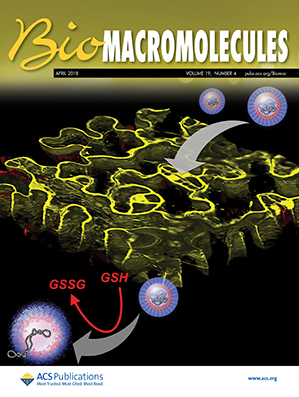外来粘蛋白改变了重组胃粘液的性质
IF 5.4
2区 化学
Q1 BIOCHEMISTRY & MOLECULAR BIOLOGY
引用次数: 0
摘要
在进化过程中,不同的黏液蛋白亚型已经进化,主要发生在身体的特定黏液变体中。这种明确的区域分配的丧失通常与病理生理状况(如哮喘或胃癌)有关。我们在此重建了来自不同粘蛋白亚型的粘液,以阐明MUC5B/MUC2污染对胃中酸性MUC5AC凝胶的生理相关特性的影响。我们的研究结果表明,这些特性可能被非典型粘蛋白物种的存在严重改变。污染粘蛋白亚型与宿主网络的弱整合产生具有增强屏障能力的弱粘弹性凝胶。揭示疾病条件下粘膜屏障的复杂特性对于理解粘膜疾病进展和开发药物载体穿越这种生物屏障至关重要。在这里,我们的结果为控制胃肠道粘液物理特性的机制原理提供了有用的见解。本文章由计算机程序翻译,如有差异,请以英文原文为准。
Foreign Mucins Alter the Properties of Reconstituted Gastric Mucus
During the course of evolution, distinct mucin subtypes have evolved, that predominantly occur in specific mucus variants of the body. A loss of this clear regional assignment is often associated with pathophysiological conditions such as asthma or gastric cancer. We here reconstitute mucus from different mucin subtypes to elucidate the influence of MUC5B/MUC2 contaminations on physiologically relevant properties of acidic MUC5AC gels as found in the stomach. Our findings indicate that these properties may be critically altered by the presence of an atypical mucin species. A weak integration of a contaminating mucin subtype into the host network yields weak viscoelastic gels with increased barrier capabilities. Unravelling the complex properties of mucosal barriers under disease conditions is crucial for the understanding of mucosal disease progression and for developing drug-carriers to traverse this biological barrier. Here, our results provide useful insights into mechanistic principles governing the physical properties of gastro-intestinal mucus.
- Download: Download high-res image (49KB)
- Download: Download full-size image
求助全文
通过发布文献求助,成功后即可免费获取论文全文。
去求助
来源期刊

Biomacromolecules
化学-高分子科学
CiteScore
10.60
自引率
4.80%
发文量
417
审稿时长
1.6 months
期刊介绍:
Biomacromolecules is a leading forum for the dissemination of cutting-edge research at the interface of polymer science and biology. Submissions to Biomacromolecules should contain strong elements of innovation in terms of macromolecular design, synthesis and characterization, or in the application of polymer materials to biology and medicine.
Topics covered by Biomacromolecules include, but are not exclusively limited to: sustainable polymers, polymers based on natural and renewable resources, degradable polymers, polymer conjugates, polymeric drugs, polymers in biocatalysis, biomacromolecular assembly, biomimetic polymers, polymer-biomineral hybrids, biomimetic-polymer processing, polymer recycling, bioactive polymer surfaces, original polymer design for biomedical applications such as immunotherapy, drug delivery, gene delivery, antimicrobial applications, diagnostic imaging and biosensing, polymers in tissue engineering and regenerative medicine, polymeric scaffolds and hydrogels for cell culture and delivery.
 求助内容:
求助内容: 应助结果提醒方式:
应助结果提醒方式:


